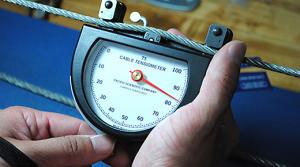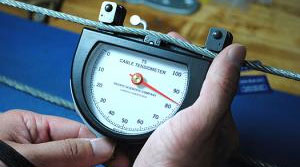All Features

Joel Smith
In part one of “Gauging Gage,” I looked at how adequate a sampling of 10 parts is for a gage repeatability and reproducibility (GR&R) study and provided some advice based on the results.
Now I want to turn my attention to the other two factors in the standard gage experiment: three operators…

Davis Balestracci
Don’t tell me you’re not tempted to look when you spot a magazine cover saying, “How does your state rank in [trendy topic du jour]?” Many of these alleged analyses rank groups on several factors, then compare the groups’ sum totals of their respective ranks to make conclusions.
For example, in…

Joel Smith
‘You take 10 parts and have three operators measure each two times.”
This standard approach to a gage repeatability and reproducibility (GR&R) experiment is so common, so accepted, so ubiquitous, that few people ever question whether it is effective. Obviously, one could look at whether three…

Fred Faltin
All of us draw conclusions based on what we see happening around us. Often what we’re observing is a sample from some larger population of events, and we draw inferences based on the sample without even realizing it. If the sample we observe is not a representative one, our resulting judgments can…

Donald J. Wheeler
Here we take a serious look at some nonsensical ideas about capability ratios. Following a quick review of predictability and capability and a brief discussion of the traditional ways of characterizing capability and performance, we will consider the shortcomings of four bits of capability…

Steve Moore
When I entered college in the fall of 1970, I had a nice slide rule (or “slipstick” as some of us called it) that I proudly carried in a leather case to my engineering and chemistry classes. Virtually everyone at North Carolina State University had a slide rule then, but by the time I was a senior…

Davis Balestracci
Many talk about reducing variation to improve quality. Does that include human variation, where everyone takes a different approach to improving overall improvement processes? What would happen if this variation were reduced?
Would some of you lean folks be interested in spearheading an effort to…

David Schwinn
This month’s column comes from a convergence of finishing my article, “Statistical Thinking for OD Professionals,” for the OD Practitioner, and reading “How Statistics Lost their Power—and Why We Should Fear What Comes Next” in the Guardian, and Weapons of Math Destruction by Cathy O’Neil (Crown…

Donald J. Wheeler
A recent question from a statistician in Germany led me to the realization that the F-test of analysis of variance (ANOVA) fame is in serious need of an update.
What the F-ratio does
The F-ratio, created by Sir Ronald Fisher around 1925, is a generalization of Student’s t-test for comparing two…

Patrick Runkel
Did you ever wonder why statistical analyses and concepts often have such weird, cryptic names?
One conspiracy theory points to the workings of a secret committee called the ICSSNN. The International Committee for Sadistic Statistical Nomenclature and Numerophobia was formed solely to befuddle…
Davis Balestracci
According to Mark Graham Brown, from his book Keeping Score (Productivity Press, 2006), 50 percent of the time leaders spend in meetings involving data is waste, 80 percent of the pounds of published financial data is waste, 60 percent of the pounds of published operational data is waste, and…
Donald J. Wheeler
The average and range chart handles most situations where the data can be logically organized into homogeneous subgroups. However, this chart breaks down when faced with a hierarchical data structure containing two or more levels of routine variation. For these situations I developed the three-way…
Bruno Scibilia
Genichi Taguchi is famous for his pioneering methods of robust quality engineering. One of the major contributions that he made to quality improvement methods is Taguchi designs.
Designed experiments were first used by agronomists during the last century. This method seemed highly theoretical at…
Davis Balestracci
Just curious: Do you have monthly (and/or quarterly and/or even weekly) “How’re we doin’?” meetings like the end-of-year scenario described in my November and December columns last year—about budgets, financials, never events, incidents, near misses, machine downtime, productivity, root cause…
Eston Martz
The language of statistics is a funny thing, but there usually isn’t much to laugh at in the consequences that can follow when misunderstandings occur between statisticians and nonstatisticians. We see these consequences frequently in the media, when new studies—that usually contradict previous…
Catherine Beare
Sponsored Content
Although efforts have been made to create policies that support a bias-free workplace, there is still a considerable way to go toward achieving the gender equality that organizations are striving for. Due in part to a lack of clear measurement and transparency, many companies and…
Donald J. Wheeler
Good measurements are like apple pie and motherhood. Who could ever be against having good measurements? Since we all want good measurements, it sounds reasonable when people are told to check out the quality of their measurement system before putting their data on a process behavior chart.…
David Schwinn
I recently presented “Statistical Thinking for OD Professionals” for the Organization Development Network annual conference. It was well received, but more important, it reignited in me a passion for the use of control charts in decision making for everyone who uses numbers, or needs to use them…
Davis Balestracci
In spite of the overwhelming odds against me, every new year I firmly resolve to reignite my relentless passion about creating a critical mass of colleagues committed to practicing improvement as “built-in” to cultural DNA using data sanity.
Will this be the year you join me?
Here is a …
Eston Martz
A member of Minitab’s LinkedIn group asked how to create a chart to monitor change by month, specifically comparing last year’s data to this year’s data. My last post showed how to do this using an Individuals chart of the differences between this year’s and last year’s data. Here’s another…

Donald J. Wheeler
What can be done when a test is destructive? How do we characterize measurement error? How can we determine if a test method is adequate for a given product or application? How can we check for bias?
All of the techniques for assessing the quality of a measurement system require us to make…
Greg Fox
It’s that time of year again. The time when eggs get nogged, pudding gets figgy, and it becomes socially acceptable to speak in rhyme. So on that note, and with apologies to Clement Clarke Moore, I bring you this timely and heartfelt public service announcement. Enjoy.
’Twas the week before…
Davis Balestracci
Those of you familiar with W. Edwards Deming know that his Funnel Experiment ultimately shows that a process in control delivers the best results if left alone. Funnel Rule No. 4, also known as a “random walk”—i.e., making, doing, or building your next iteration based on the previous one—has been…
Barbara A. Cleary
Statistics has gotten a bad rap. People love to quote Mark Twain (“There are lies, damn lies, and statistics,” alternatively attributed to Benjamin Disraeli), Vin Scully (“Statistics are used much like a drunk uses a lamppost: for support, not illumination”), or Stephen Leacock (“In ancient times…
Steve Daum
Capability analysis is a set of calculations used to assess whether a system is able to meet a set of requirements. Customers, engineers, or managers usually set the requirements, which can be specifications, goals, aims, or standards.
The primary reason for doing a capability analysis is to…